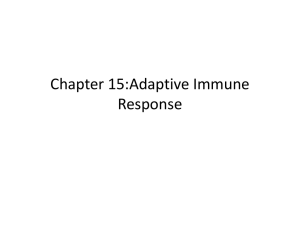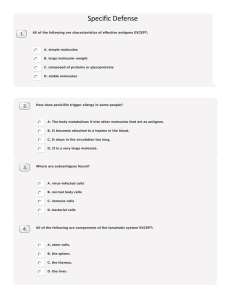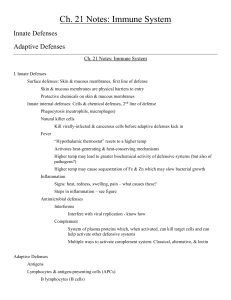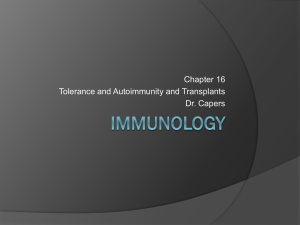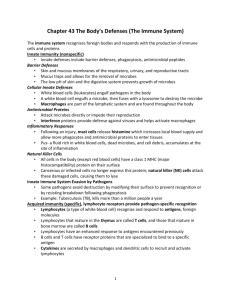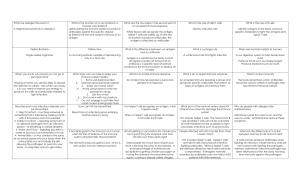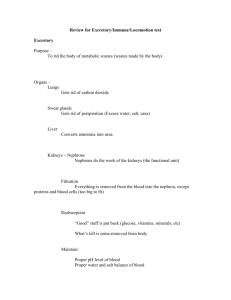Jessica Phelan
advertisement
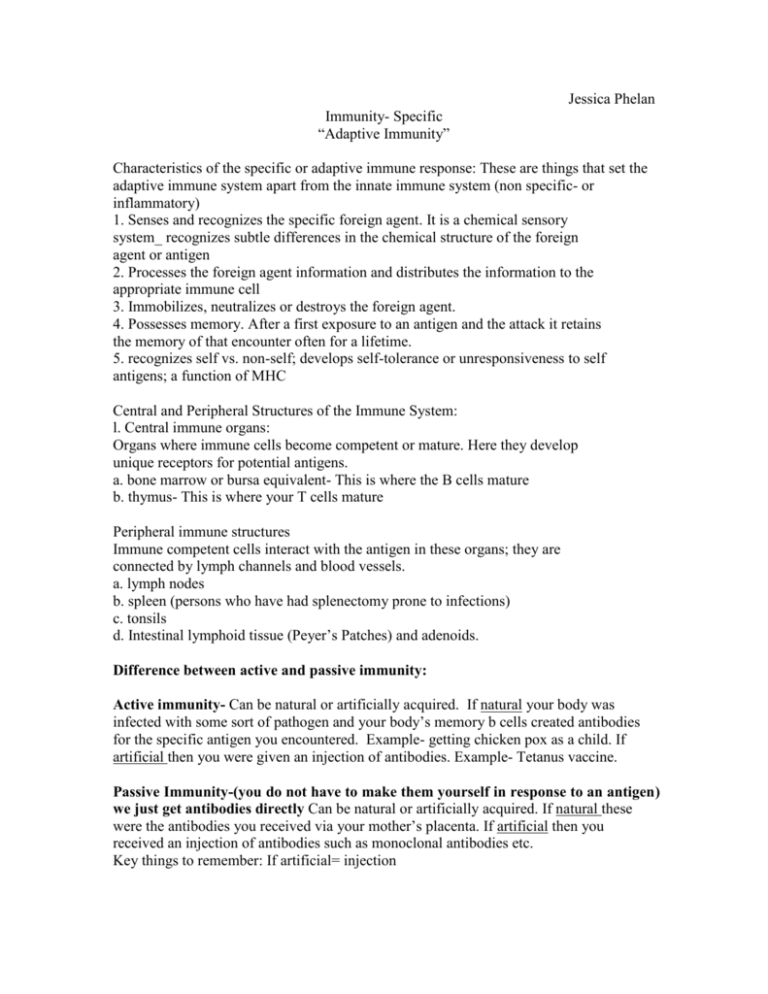
Jessica Phelan Immunity- Specific “Adaptive Immunity” Characteristics of the specific or adaptive immune response: These are things that set the adaptive immune system apart from the innate immune system (non specific- or inflammatory) 1. Senses and recognizes the specific foreign agent. It is a chemical sensory system_ recognizes subtle differences in the chemical structure of the foreign agent or antigen 2. Processes the foreign agent information and distributes the information to the appropriate immune cell 3. Immobilizes, neutralizes or destroys the foreign agent. 4. Possesses memory. After a first exposure to an antigen and the attack it retains the memory of that encounter often for a lifetime. 5. recognizes self vs. non-self; develops self-tolerance or unresponsiveness to self antigens; a function of MHC Central and Peripheral Structures of the Immune System: l. Central immune organs: Organs where immune cells become competent or mature. Here they develop unique receptors for potential antigens. a. bone marrow or bursa equivalent- This is where the B cells mature b. thymus- This is where your T cells mature Peripheral immune structures Immune competent cells interact with the antigen in these organs; they are connected by lymph channels and blood vessels. a. lymph nodes b. spleen (persons who have had splenectomy prone to infections) c. tonsils d. Intestinal lymphoid tissue (Peyer’s Patches) and adenoids. Difference between active and passive immunity: Active immunity- Can be natural or artificially acquired. If natural your body was infected with some sort of pathogen and your body’s memory b cells created antibodies for the specific antigen you encountered. Example- getting chicken pox as a child. If artificial then you were given an injection of antibodies. Example- Tetanus vaccine. Passive Immunity-(you do not have to make them yourself in response to an antigen) we just get antibodies directly Can be natural or artificially acquired. If natural these were the antibodies you received via your mother’s placenta. If artificial then you received an injection of antibodies such as monoclonal antibodies etc. Key things to remember: If artificial= injection Example test question regarding this: You go to the doctor’s office and receive a hepatitis B vaccine. What kind of immunity is this? Answer: active immunity- artificial If you had received human immunoglobulin or anything with antibody or immunoglobulin in the name injection it would have been passive artificial. Cells Involved in Immune System (In the interests of time I am not going to go into Immunoglobulins since I went so in depth into them on Sunday and wrote out everything on the white board at the review session) Make sure you know the things that I stressed about them.) B cells- synthesize and secrete antibodies with the ability to react with specific antigen. Humoral immunity. Plasma B cells secrete antibodies (IgA, IgE, IgG) which enhance opsonization. Memory B cells are formed specific to the antigen(s) encountered during the primary immune response; able to live for a long time, these cells can respond quickly upon second exposure to the antigen for which they are specific. They can only be activated to attack the antigen if a T helper cell shows it to them *Markers to know for exam CD19, CD20, CD21 T Cells- Play a central role in cell-mediated immunity. Cytotoxic T cells (Tc cells) destroy virally infected cells and tumor cells, and are also implicated in transplant rejection. CD8 cells Activated Helper T cells (Th cells) divide rapidly and secrete small proteins called cytokines that regulate or "help" the immune response. CD4 cells. Important: HELPER T cells do not kill pathogens directly. The only “help” by activating more B and T cells and they present the foreign antigen to the CD8 cells so that they can find it. Think of it as cytotoxic T cells seeing-eye dog. Important markers for exam: CD4, CD8, and CD3. (CD3 is found on both cytotoxic and helper T cells.) Test your learning practice question: What markers are found on a cytotoxic T cell? a.) CD14 b.) CD4 c.) CD8 d.) CD3 e.) CD19 f.) Answer a + b g.) Answer b + c + e h.) Answer c+ d Correct Response: H. (explanation: a is found in macrophages, b is found in helper t cells, c is found in cytotoxic T cells, d is found in both helper t cells and cytotoxic T cells and e. is found in B cells. He could ask questions like this regarding markers for B, T, natural killer cells, and macrophages. MacrophagesMacrophages are attracted to a damaged site by chemical substances through chemotaxis The life span of a macrophage ranges from months to years Macrophage will present the antigen to helper T cells Phagocytosis and kill bugs intracellularly Identified by marker CD14 You can think of them as the seeing-eye dog’s own Seeing Eye dog. First the macrophage finds the infection, it then shows it to the helper t cell that shows it to the cytotoxic t cell to be destroyed. Natural Killer Cells Kill infected and malignant cells No typical T or B cell receptors, absence of CD3 Cell surface protein: CD16 and CD56 How does the body recognize self vs. non self?? MHC- Major Histocompatibility Complex In humans, the MHC gene products are termed human leukocyte antigens or HLA’s MHC genes are on chromosome 6 MHCs function in immune recognition Your ABCs of MHC class I MHC class I includes HLA-A, HLA-B, and HLA-C MHC Class I are recognized by CD8 cytotoxic T cells. They are endogenously synthesized which means the antigens are made from within the infected cell. (antigens eaten by a phagocytic cell) These are most commonly found in viral infections. Mind your Ps and Qs about MHC classII. (these are just quirky little ways to remember the different antigens involved for each class.) MHC class II includes HLA-DP, HLA-DQ, HLA-DR. MHC class II are recognized by CD 4 helper T cells. They are exogenously synthesized which means the antigens are made from outside the infected cell. These are most commonly found in bacterial infections. Refresher: Secondary immune response much quicker than the first. Vaccination produces a primary immune response Booster shots cause a secondary immune response so antibody levels will be high before the disease is encountered Key things to remember for the exam: IgG + IgM = classic pathways (good way to remember is GM makes classic cars) Know all markers for all types of cells- example CD14, CD19, CD8 etc… Complement pathway Anything else I said “know this for exam” (This list is not comprehensive just a guide) Other things to remember to study: Anticancer drugs- which specific drugs create unique side effects. (such as cardiomyopathy, major bone marrow suppression, no bone marrow suppression, blood in the urine (hematuria) etc. Look for the ones that are different. Study paraneoplastic syndrome- specifically what happens with lung cancer Know biggest sign of cancer- Catexia- and how it works (cytokines effecting satiety center, as well as TNF) not to mention nausea/vomiting, loss of appetite, etc. Study irreversible cell death versus reversible cell death. (side effects of hypoxia etc.) And of course study your review sheet. Everything that you need to know for the exam is on that review sheet that he put on d2l. Just have everything on that sheet down pat. Any questions you can email me and I will try to answer them or email the TA. Good Luck!!!!!!!!
